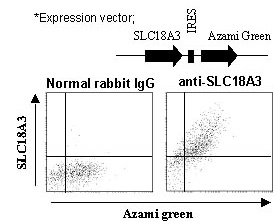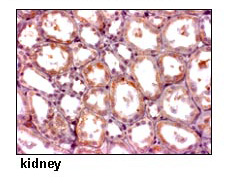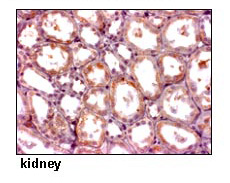Anti-SLC18A3 (VAChT) (Human) pAb
| Code | Size | Price |
|---|
| MBL-BMP048 | 50 ul | £323.00 |
Quantity:
Prices exclude any Taxes / VAT
Overview
Host Type: Rabbit
Antibody Isotype: IgG
Antibody Clonality: Polyclonal
Regulatory Status: RUO
Target Species: Human
Applications:
- Flow Cytometry
- Immunohistochemistry (IHC)
Shipping:
4°C
Storage:
-20°C
Images
Documents
Further Information
Applications:
FCM - 1:200 IHC - 1:5000 (Heat treatment required for paraffin)
Background:
SLC18A3, also known as the
vesicular acetylcholine transpor
ter (VAChT), belongs to the
family of vesicular monoamine transporters (VMATs). It is
localized to the cell membranes in the peripheral and
central cholinergic nervous
systems and transports the
neurotransmitter acetylcholine,
which is synthesized by the
enzyme choline acetyltransf
erase from the compounds
choline and acetyl-CoA, into th
e synaptic secretory vesicles.
The transport of acetylcholine oc
curs via a proton gradient
established by vacuolar ATPase. In addition, the
SLC18A3
gene is located within the first intron of the choline
acetyltransferase gene, and pr
otein kinase A appears to
regulate transcription at this cholinergic gene locus.
Formulation:
50 ul volume of PBS containing50% glycerol, pH 7.2. No preservative is contained.
Gene IDs:
Human: 6572 Mouse: 20508
Immunogen Translated:
Synthetic peptide derived from human SLC18A3
Reactivity:
This antibody can be used to stain
endogenous antigen in paraffin embedded human tissues
including kidney by Immunohistochemistry. The reactivity
has been confirmed by intracellular Flow cytometry to
detect the full length of human SLC18A3 transiently
expressed in HEK 293T cells.
Shelf Life:
1 year
Source:
This antibody was affinity purified from rabbit
serum. The rabbit was immunized with a synthetic peptide
derived from human SLC18A3.
Target:
SLC18A3/VAChT
References
?1) Elwary, S. M., et al., J. Invest. Dermatol. 126, 1879-1884 (2006)
2) Varoqui, H., and Erickson, J. D., J. Biol. Chem. 271, 27229-27232 (1996)
3) Erickson, J. D., et al., J. Biol. Chem. 269, 21929-21932 (1994)






